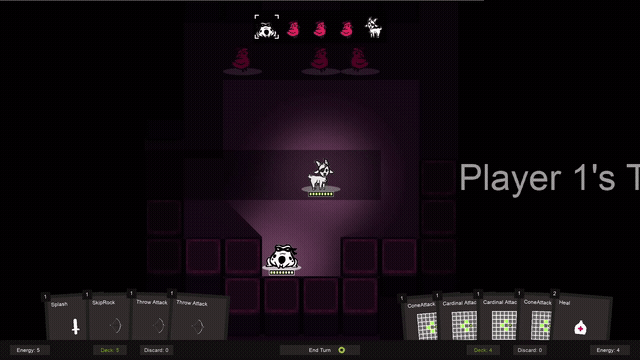Let There Being Lighting!
Preface
Since my initial portfolio listing, the game has changed a lot and it seemed appropriate to start doing blog post-style updates. I probably won’t have a regular cadence to these posts, but I plan to do them whenever I feel the game has changed significantly since the last post.
Let There be Lighting!
Probably the most immediately noticeable change since the first post is the implementation of 2D lighting and Fog or War!
As the players move about the grid of an encounter their light source will uncover the tiles hidden in the shadows. Treasures and enemies can be hiding in the shadows; if they are in a player’s light radius, they won’t be added to the turn order array. I added this “edge of the shadows” feature to allow players to explore a little more safely and choose whether or not they want to engage before diving headfirst into some enemies… a “perception check” of sorts.
The image below shows both players within the Lit Tiles and the enemy birds in the unshaded tiles. Because the enemy birds aren’t lit up they haven’t been added to the turn order yet giving the players an opportunity to plan out how they want to approach or avoid the situation.
This next image shows the Goat player having moved closer to the birds lighting up the tiles they are on and adding them to the turn order. As the players move about the level the opaque shaded tiles become unshaded revealing the surrounding.
I don’t see this mechanic as something that is in every encounter so I built the system in such a way that I could start the encounter with a certain amount of lit tiles or shaded depending on the level design goals.
One of the reasons I did add this mechanic into the game is to encourage players to stick together. I find that all too often in Coop games being separated from your buddy can be a real drag and mess up the camera, make it easier for each of you to get flanked, etc. So instead of punishing players for being apart, I encourage them to stick together by giving the current player who’s turn it is additional energy if they start their turn in the light radius of their Coop buddy.
A quick player feedback note that is worth mentioning here. I found in my playtesting that players would find themselves in emptied rooms after killing all the enemies and then have to spend several turns using all their energy to leave the room and explore else. One tester suggested reducing the movement energy cost to 0 within the unshaded tiles if there are no enemies around.
I quite like this idea and it felt better right away for getting back into the action… at least for one player that is. So far the results have been mixed with one player able to explore and get into new trouble right away and the other player having to spend a few turns catching back up. This doesn’t seem Coop-friendly to me but I am unsure how to address the issue at this time. For now, I am leaving the mechanic as is, collecting more player feedback, and will later down the line come back later to this problem with fresh thoughts on how to fix it.
Prototype Art Update!
The other noticeable visual change is the addition of cute little pirate animals for units! The assets themselves are courtesy of Kylie O’Keefe with the animations coded by yours truly.





The current creative theming I have in mind is a Peter-Pan-Like-Fantasy-Pirate setting with cute little animals like these ones as characters. Everything is still WIP and subject to change though so don’t get too attached!
Change In Design Direction
Since the initial post I have received a lot of feedback on the concept and have done a lot of thinking about the design direction of CardsGrid. Because I am aiming for this to be a fun Coop experience where a “campaign” could last a 2-player pairing through the weekend it doesn’t really make sense to try an add rogue-like elements to the design. I don’t want the failure of an encounter in CardsGrid to be an end state. Much like in DND I want players to be able to create their own unique stories they can share with others. I want to encourage rolling with the punches and am leaning away from rogue-like deck builder design and doubling down on old-school party-based RPG design instead where character / deck progress can be a longer and more interesting journey. Below are my new high-level design slides capturing this idea.


Looking Ahead
The next big thing I want to focus on is building encounters that challenge and ask the players specific questions like:
Does the group have enough… Damage or Healing or Movement?
Does the group know how to protect and help each other?
As I build these encounters, I also want to ensure my workflow for making them is smooth, not tedious, and easily variable/adjustable. I foresee having hundreds of encounters that are variable depending on the group’s stats thus far in the campaign. Keeping in mind my next goal of being able to load up multiple encounters in a play session and carry player progression between each encounter.
With all that mind, below are the upcoming tasks I mapped out for myself.





